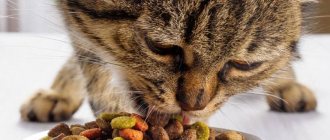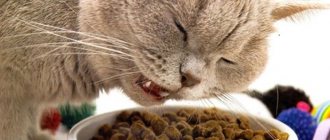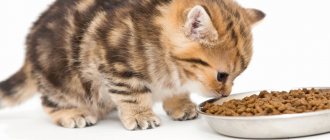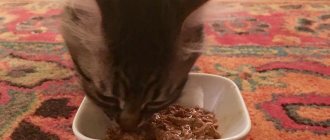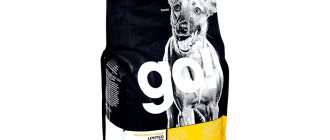The main disadvantages of dry food
Dry food contains too many artificial ingredients. If you carefully study the composition of any dry food, you can find:
- food additives E,
- food gelatin,
- table salt,
- coagulants,
- antioxidants,
- fat burners,
- additives that become poisonous when they accumulate in the animal’s body.
Many additives cause allergies and digestive disorders in pets. Cats and dogs that eat only dry food are more prone to obesity and diabetes.
Every owner has heard about the composition of dry food at least once, but industrial food still has a number of disadvantages.
Water content too low
The pets' diet should contain at least 65%-75% humidity. The body of dogs and cats is accustomed to receiving the required amount of water from food.
The natural prey of cats and dogs contains about 70% liquid
The water content in dry food is less than 10%, which is very little. The pet's body receives much less water than it needs. Cats and dogs that eat dry food drink more water than pets that eat wet food. But at the same time, the former still receive approximately two times less liquid than the latter. Because of this, pets are in a constant state of dehydration and excrete more concentrated urine. This leads to diseases of the lower urinary tract.
Too high carbohydrate content
The carbohydrate content in dry food reaches 50%. In nature, cats and dogs feed on prey: rodents, rabbits, insects and birds. In such a diet, the carbohydrate content does not exceed 2%.
Cats and dogs have specific physiology that matches their natural diet. They do not have the specific enzyme chains that other mammals have, and they do not have amylase, an enzyme in saliva. Therefore, cats and dogs do not digest carbohydrates well.
The level of carbohydrates in dry food increases due to the fact that it contains grains. Carbohydrates are converted into sugar in the body. Excess carbohydrates lead to obesity and diabetes. A number of studies have found that there is a link between the amount of sugar pets consume and serious illnesses, including cancer.
Due to the high sugar and carbohydrate content, L-carnitine is added to the feed. This substance should promote fat burning. But it has not been proven to actually benefit pets.
A person perceives carbohydrates as a source of energy because this is how human physiology works. Cats and dogs are carnivores and get their energy from protein and fat.
Wrong protein
The energy value on dry food packaging can be misleading for pet owners. It seems that the protein content is sufficient, but you need to understand that most of the protein is obtained from plants.
One of the main ingredients in dry food is poultry meal. It consists of crushed feathers, paws, claws, and beaks. It is difficult to detect these components in feed in the form of flour. But because of this component, the quality of the protein is noticeably reduced.
Dry foods often contain corn gluten. This is a protein residue from industrial processing. Corn gluten contains a lot of vegetable protein, which the body of predators does not absorb well. Gluten interferes with bowel movements: it retains indigestible substances in the body. These substances accumulate and become poisonous to the animals. All this creates a significant burden on the kidneys and liver of pets.
Animal and plant proteins differ in amino acid content. For example, cats need taurine, and it is only found in animal protein. Cats and dogs get essential amino acids from meat, fish, eggs and poultry. Legumes, grains and vegetables, which are often included in dry food, cannot provide pets with all the necessary microelements.
Flavoring additives
Dry food itself does not arouse interest in dogs and cats. To increase the appetite of animals, manufacturers add flavorings and flavoring additives. One such supplement is sodium tripolyphosphate. It is an artificial stabilizer, emulsifier and acidity regulator. Manufacturers add artificial vitamins, minerals and amino acids to feed, which reduce the nutritional value of the product. Sodium tripolyphosphate is used to increase it. As already mentioned, artificial additives cause allergies and lead to digestive problems.
Risk of bacterial infection
If the grain from which the food is made has not been stored properly, the dry food may become contaminated with mold, fungus or mycotoxins. For the production of dry food, cheap, low quality raw materials are used, which are not suitable for human consumption. Dry food must be stored correctly: do not allow it to become moist. A humid environment promotes the production of mycotoxins.
Risk of salmonella infection
There have been many cases where manufacturers have recalled dry food because it was contaminated with salmonella. Owners are usually wary of salmonella when it comes to feeding raw meat. As it turned out, the risk of contracting salmonella from dry food is higher. The reason is that people tend to handle it carelessly, but are accustomed to following strict safety rules when handling meat.
The risk of contracting salmonella from raw meat is very low. Especially if human-grade meat is used to prepare the food
Wheat, vegetables and beef blood: myths about cat food
The history of the appearance of ready-made diets for animals dates back to the distant 1860s, when the American electrician James Spratt invented the so-called “dog biscuit”, which included beef blood, vegetables and wheat. More than a dozen years passed before cat food manufacturers started talking about the need to create a balanced, easily digestible, safe product that can satisfy all the nutritional needs of domestic cats.
Over the course of a century and a half, industrial food for dogs and cats has undergone significant changes. Thanks to technology, as well as the joint work of scientists and veterinarians, the variety of cat foods that can be seen today has appeared. Dry croquettes, pieces of meat in jelly, all kinds of pates - a real feast for the belly! However, despite the convenience and huge selection, not all owners prefer ready-made diets. Why?
Perhaps the main reason for the mistrust of ready-made diets is the widespread myth that cat food is made from soy products and unedible animal parts - horns, hooves, skins and feathers, flavored with flavor improvers and preservatives. In turn, this myth gives rise to another erroneous opinion: any food from the master’s table is much healthier than all this “chemistry”. Is it really? Let's figure it out.
Field trip to the Mars Petcare plant
How does eating dry food affect your pet's health?
You could argue that many cats and dogs eat dry food and are fine. But any living creature seems healthy until external signs of illness appear.
Check out forums for owners of sick pets. All the animals mentioned there were eating dry food and were fine until their owners began to notice signs of illness:
- urination has become difficult due to the blocked urethra;
- pets with cystitis began to experience acute pain, blood began to come out in the urine, and they began to relieve themselves throughout the house;
- pets began to lose their appetite, suffer from food intolerance, intestinal inflammation and asthma;
- kidney stones continued to grow until clinical signs appeared;
- Cancer patients' tumors continued to grow until obvious symptoms appeared.
In other words, diseases can remain undetected for a long time, and all this time develop into more severe forms.
Advantages
First, let's talk about the advantages of using dry pet food.
Plastic containers, which are found in every home, will work great. Separately, it is worth noting the long shelf life of the products and convenient use. To feed your furry pet, just open the package and pour the required amount of food into a bowl.
Without the use of ready-made food, cat owners have to create their own menu, taking into account the characteristics of a particular breed and the beneficial qualities of each individual product. Trading companies offer food for various age groups, taking into account the developmental characteristics of cats at each stage.
It is especially worth noting medicinal food, which helps animals recover after surgery or illness. They contain special components aimed at improving the condition of the body. You will also find formulations for pregnant and lactating cats on sale.
- maintaining excellent vision of the animal;
- prevention of heart disease;
- participation in digestive processes (the substance helps digest and absorb fat in the small intestine);
- stabilization of the nervous system.
Taurine is found in fish, beef and seafood. If such food is rarely or completely absent from the cat’s diet, dry food will help cope with the problem of taurine deficiency.
How to provide your pet with a healthy diet
To keep your pets healthy and happy for many years to come, it is enough to provide them with a healthy diet.
Considering the disadvantages of dry food, create a healthy diet:
- there should be a sufficient amount of liquid in food;
- carbohydrate content should be minimal;
- use animal protein;
- use raw bones for dental health,
- Buy products only from trusted suppliers.
If you are not comfortable preparing healthy food yourself, pay attention to ready-made natural food, for example, SUPERPET.
Remember that a natural diet is the key to your pet’s health.
Did you like the article? Share with your friends:
Advantages
First, let's talk about the advantages of using dry pet food.
Plastic containers, which are found in every home, will work great. Separately, it is worth noting the long shelf life of the products and convenient use. To feed your furry pet, just open the package and pour the required amount of food into a bowl.
Without the use of ready-made food, cat owners have to create their own menu, taking into account the characteristics of a particular breed and the beneficial qualities of each individual product. Trading companies offer food for various age groups, taking into account the developmental characteristics of cats at each stage.
Separately, it is worth noting medicinal foods that help animals recover after operations or illnesses. They contain special components aimed at improving the condition of the body. You will also find formulations for pregnant and lactating cats on sale.
- maintaining excellent vision of the animal;
- prevention of heart disease;
- participation in digestive processes (the substance helps digest and absorb fat in the small intestine);
- stabilization of the nervous system.
Taurine is found in fish, beef and seafood. If such food is rarely or completely absent from the cat’s diet, dry food will help cope with the problem of taurine deficiency.
The influence of habitat on the nutritional needs of cats
The ancestors of modern cats, living in nature, fed on small rodents, birds and fish, eating them along with their skin and entrails. In this way they met their needs for minerals, vitamins and cellulose. Living close to humans, felines have adapted to eating leftover human food. Natural selection shaped the appearance of the modern domestic cat, and non-viable races became extinct. Newly created man-made ornamental breeds are prone to diseases, so they require special food.
The habitat has changed. If cats that eat Kitty-Kat diversify their diet with mice and also grass, then those living in apartments of high-rise buildings are deprived of this opportunity. Adynamia develops from lack of movement, so the need for calories decreases. Animals are deprived of the joy of communicating with the opposite sex. The owners, observing the suffering of their pet, decide to sterilize. Metabolism, and therefore the need for nutrients, changes dramatically. Therefore, regular food becomes toxic for cats. The consistency of the feed is of particular importance. Some animals, due to their physiological characteristics, age and lack of teeth, are recommended to use wet food.
The main advantage of semi-liquid food is that it facilitates the transition from milk to solid food. For dental diseases or stomatitis, it is recommended to exclude hard particles from the diet. Some fellinologists believe that it is better to feed sterilized cats soft food. However, constant feeding of wet food contributes to the formation of dentolits and the occurrence of gingivitis. Wet food spoils quickly, so some cat owners prefer to alternate it with solid food.

